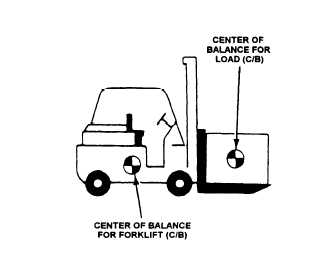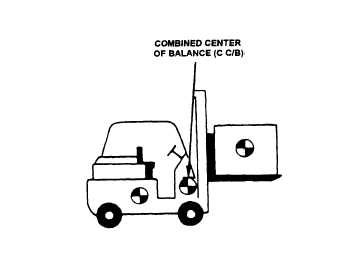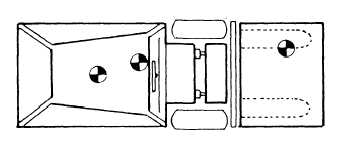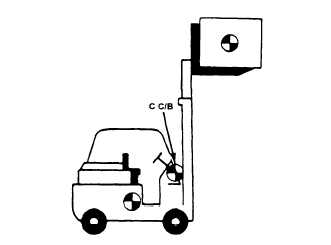The center of balance is a critical factor for capacity.
On most forklifts, the center of balance (C/B) is under
the operator’s seat, as shown in figure 8-15. When a
load is lifted a combined center of balance (C C/B) is
created, as shown in figure 8-16. When the load is
raised, the C C/B changes, as shown in figure 8-17.
A forklift is designed to lift its maximum capacity
with the load centered on the forks, not with the tip of
the forks.
CAUTION
Never lift a load with the load balanced on
the tips of the forks.
You should know where the center of balance (C/B)
is before trying to lift any load. The C/B of the load
should be as far back on the forks as possible. If the C/B
Figure 8-15.—Center of balance (C/B) for the forklift and load.
moves with the C/B of the load.
Figure 8-16.—Combined center of balance (C C/B).
Figure 8-17.—Movement of the combined center of balance as
the load is raised.
is on one side, as shown in figure 8-18, the load may flip
off the forks and land on its side once you lift it. The
C/B of the load should be placed directly in front of the
C/B of the forklift, as shown in figure 8-19.
Additionally, the C/B should be centered and placed as
far back as possible on the forks.
OPERATING TECHNIQUES
Before operating a forklift, you must have proper
authorization and possess a thorough understanding of
the operator’s manual and safety precautions. If you
have very little experience in operating forklifts, make
sure a qualified operator guides you through at least
several operating and load-handling operations before
Figure 8-18.—Top view of how the combined center of balance
Figure 8-19.—How the C/B of the load should be centered
8-9










